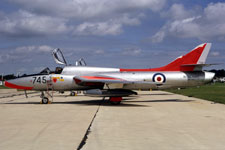| WT745's service history
Hunter WT745 was built as a Mk.4 single seat fighter for the Royal Air Force by Hawker Aircraft Ltd at its Kingston-Upon-Thames factory. It was test flown for the first time on 2nd March 1955 by test pilot Neville Duke and following flight testing was delivered to the RAF at Kemble a month later.
Prepared by the resident 5 Maintenance Unit (5MU) for military service, WT745 was ferried to RAF Oldenburg in West Germany where it was issued to RAF 14(F) Sqn and use in the day fighter role. It remained in service until its role was taken over by the Hunter F.6 variant and was returned to the UK shortly after and placed in store.
With the prospect of further RAF service looking unlikely, WT745 was sold back to Hawker Aircraft for refurbishment and potential resale.
During 1958, the airframe was selected for conversion to T.8 specification to fulfil an order from the Royal Navy, with the required conversion work being undertaken by Armstrong-Whitworth at Coventry. It was delivered to the Fleet Air Arm at Royal Navy Air Station (RNAS) Lossiemouth on 26th May 1959, where it was prepared for military use by the resident Aircraft Handling Unit. Just under 12 months later, WT745 was delivered to RNAS Yeovilton where it was issued to 766NAS (Navy Air Squadron) as '947' with 'VL' shore code lettering applied on the tail fin. Used for training purposes alongside the Squadron's fleet of de Havilland Sea Vixen FAW.1 airframes, it remained with them until a transfer to Heron Flight on 20th December 1962, keeping its '947' identity.
Following a period on the ground at Sydenham undergoing a modernisation programme (from November 1963), WT745 was ferried to RNAS Brawdy in September 1964, to be prepared for its next posting, which commenced in February 1965 when it was issued to 764NAS as aircraft '688' with a 'LM' tail code applied.
Its life with the Squadron was not without incident, as it suffered multiple bird-strikes, engine vibrations and even an occurrence when its landing parachute streamed mid-flight. During July 1969, the airframe was withdrawn from use with 764NAS and ferried to 5MU for modernisation work.
On 7th July 1970, WT745 was officially transferred onto the strength of the Air Direction Training Unit (ADTU) at RNAS Yeovilton. Maintained by civilian engineers from Airwork Services Ltd under contract to the Royal Navy, it was initially issued the fleet number '742' but this was quickly revised to '745' and applied to the airframe. It was utilised for training duties for the next two years, and in December 1972, was absorbed into the newly formed Fleet Requirements and Air Direction Training Unit (FRADTU)'s pool of airframes, following its creation and the merger between the ADTU and Fleet Requirements Unit (FRU).
Its FRADTU service lasted just 47 days as on 16th January 1973, it was ferried to RAF Kemble for long term store with 5MU. WT745 remained in reserve at Kemble until 8th November 1982 when, due to the imminent closure of the airfield it was moved by road for future storage to RAF Shawbury. However, just before its move WT745's rear fuselage was exchanged with that of Hunter T.7 XL565, which was at the time being prepared for FRADU service.
With no prospect of WT745 ever being needed for military service again, it was grounded, issued the RAF maintenance serial 8893M and the airframe sent to RAF St Athan for paint finishing training. However, its life there was brief as its cockpit section was separated and sold into private ownership. The remnants of the airframe were then moved to RAF Coltishall for Battle Damage Repair Training, and it soldiered on there until offered for disposal in the summer of 1990. |

[© Adrian M Balch]
|
WT745's civilian life
WT745 minus its cockpit was sold for scrap and it was moved to a premises at Faygate in August 1990.
It escaped the smelter initially however, as two months later Jet Heritage at Bournemouth Airport acquired it for spares recovery, eventually scrapping what remained in 1992.
As mentioned earlier WT745's cockpit section was sold shortly after the airframe arrived at RAF St Athan.
Its new owner was Ed Stead, who bought the cockpit section for use in a Hunter restoration project in Manchester, New Hampshire, USA.
It arrived there in July 1987, and was mated with the single seat fuselage and wings of an ex-Swedish Hunter, serial number 34006, to form a two-seat aeroplane. Placed on the FAA register as N745WT, the restoration programme took a total of 12 years, eventually being completed in June 1998.
Tragically, on its first test flight the aeroplane crashed on final approach, killing the former US Air Force pilot aboard. The subsequent accident report stated that fuel starvation was the cause of the accident, due to a faulty fuel quantity reading on the cockpit instruments. The pilot delayed his ejection until he had ensured that the aeroplane would avoid people and property on the ground, an act that may have cost him his life.
- December 2020 |
